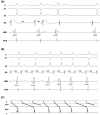Isolated palpitations and ventricular pre-excitation
- PMID: 32782659
- PMCID: PMC7411198
- DOI: 10.1002/joa3.12358
Isolated palpitations and ventricular pre-excitation
Abstract
A 27-year-old male was referred for further assessment after being evaluated by his general practitioner for isolated palpitations. A twelve-lead electrocardiogram was performed in which sinus rhythm with ventricular pre-excitation were observed. Electrophysiologic study demonstrated the presence of a fasciculoventricular accessory pathway.
Keywords: accessory pathway; electrophysiology; tachycardia.
© 2020 The Authors. Journal of Arrhythmia published by John Wiley & Sons Australia, Ltd on behalf of Japanese Heart Rhythm Society.
Conflict of interest statement
None.
Figures


References
-
- Gallagher JJ, Smith WM, Kasell JH, Benson DW Jr, Sterba R, Grant AO. Role of Mahaim fibers in cardiac arrhythmias in man. Circulation. 1981;64:176–89. - PubMed
-
- O'Leary ET, Dewitt ES, Mah DY, Gauvreau K, Walsh EP, Bezzerides VJ. Differentiation of fasciculoventricular fibers from anteroseptal accessory pathways using the surface electrocardiogram. Heart Rhythm. 2019;16:1072–9. - PubMed
-
- Sternick EB, Oliva A, Gerken LM, Magalhães L, Scarpelli R, Correia FS, et al. Clinical, electrocardiographic, and electrophysiologic characteristics of patients with a fasciculoventricular pathway: the role of PRKAG2 mutation. Heart Rhythm. 2011;8:58–64. - PubMed
LinkOut - more resources
Full Text Sources

